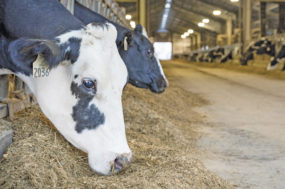Telematics is a useful tool installed in today’s heavy equipment, yet it can be one of the most underutilized assets.
Including telematics in your regular machine maintenance increases your efficiency, and it can keep your dairy operation working on schedule.
Manufacturers started incorporating telematics systems in heavy equipment during the last couple of decades. They offer a wealth of beneficial information. Two of the most useful data points are what your machine is doing and where it is. You can think of telematics as a smartwatch for your wheel loader. Telematics let you track its vitals in real time, see its history and keep track of its location.
The system can send you notifications, reminders and alerts. Depending on the brand of your wheel loader, the data is accessible on an app or by logging into a website. This means you and your dealer can monitor the health of your wheel loader and ensure it’s running efficiently.
Telematics management systems provide detailed reports. Some telematics reports include: fuel usage, error codes, and engine and hydraulic oil temperatures. Your equipment dealer can help you customize your notifications and avoid overloading your email inbox.
Here are five easy ways to make the most of your telematics system on your wheel loader:
No. 1: Manage your fleet
If you have more than one wheel loader at your dairy operation, telematics can be a way to better manage your machines. The system gives you access to valuable machine information. You can use it to track machine usage and help protect the machine from unplanned downtime. For example, you can monitor the use of equipment so you know how often each one is being operated. You can determine if you are using your wheel loaders more or less than you would like. The data may show that investing in another machine could be a smart move at your dairy operation.
No. 2: Track fuel consumption
Another area that can benefit from telematics is fuel efficiency. Since you can see how much fuel your machine consumes during a period of time, you can use that to set a baseline and monitor your diesel fuel consumption. You may learn that your operators are using more fuel than you thought. You can use the report as a teaching tool for operators, especially if they’re letting the machine idle. Unnecessary machine idling not only wastes fuel but also machine warranty hours.
No. 3: Track maintenance
When running a dairy operation, there isn’t much room for machine downtime. You want your wheel loader to work when you need it. The best way to do that is to keep up with preventive maintenance. That can be challenging when you’ve got a lot of other tasks to do. Utilizing your wheel loader’s telematics data can be a way to help. It provides you with a system to track your service needs and get maintenance warnings. To give you some context, you can see fault code statuses and see your machine’s history.
Maintenance alerts can help you stay on top of your machine’s health. Even if you are busy with other responsibilities, reminders will help you keep your machine in good condition. Often, these warnings provide you with statuses on machine parts, letting you know their general condition and the number of hours used. If you find it’s hard to keep up with your machine’s maintenance schedule, you can set up a system with your dealer. Since they can access your machine’s telematics data, they can proactively reach out to you when service needs are present or upcoming. Some dealers offer on-site field service with mobile lubrication trucks, performing fluid changes at your farm.
No. 4: Plan ahead
A benefit to utilizing telematics is the opportunity to stay on top of your machine maintenance. You can see when your wheel loader will need service and mark it on your calendar. You can also use this information with your calendar to find times that work best for you to get your wheel loader serviced. Your telematics data might show you that your machine will need an oil change in two weeks’ time. You can be proactive and schedule the oil change earlier.
If an unexpected issue comes up, your telematics system sends you fault and warning codes in real time. Since this data is shared with your dealer, you can get help on the way quickly, without having to relay the issue yourself. Even better, if there is an issue, dealers can also use that data to help diagnose the problem without having to physically check your machine, saving time and money.
No. 5: Monitor usage
Equipment theft and unauthorized use of machines is something no one wants. Luckily, another feature of telematics is equipment GPS location information. With this, you know where your wheel loaders are and when they’re being operated. The telematics system allows you to see the last reported position of your machine. This means you can worry less about keeping tabs on your equipment and pay more attention to your farming operations.
If you’re not already using telematics data in your dairy operation, contact your dealer for more details. Your dealer can answer any questions you may have about telematics and get you set up on your smartphone or computer so you can access this valuable information.







